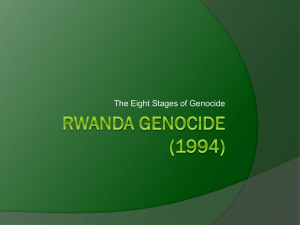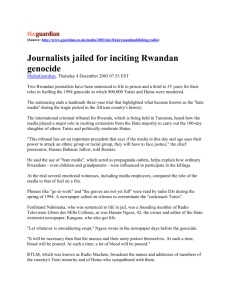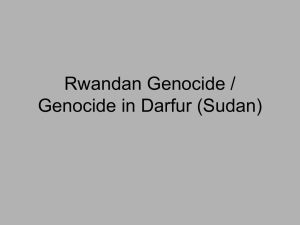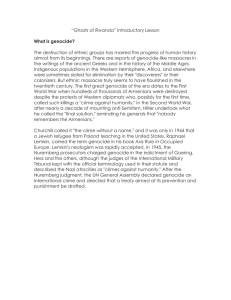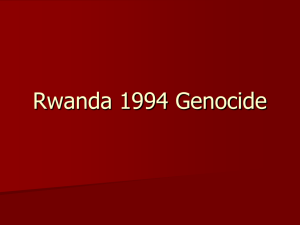Rwanda: How the Genocide Happened
advertisement
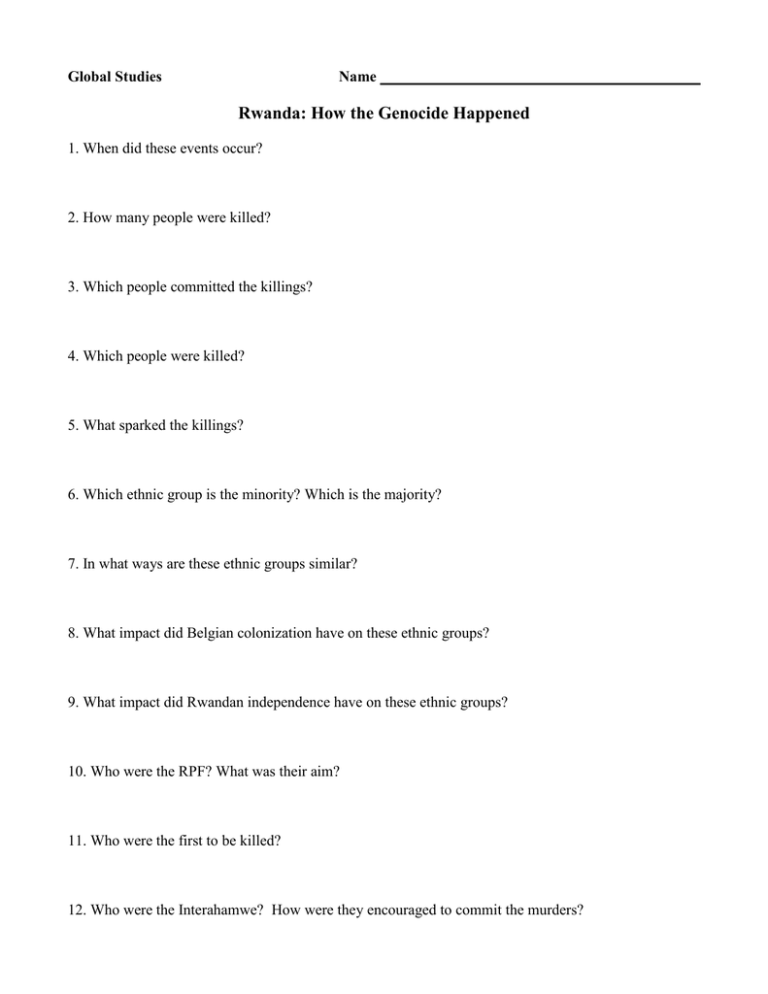
Global Studies Name Rwanda: How the Genocide Happened 1. When did these events occur? 2. How many people were killed? 3. Which people committed the killings? 4. Which people were killed? 5. What sparked the killings? 6. Which ethnic group is the minority? Which is the majority? 7. In what ways are these ethnic groups similar? 8. What impact did Belgian colonization have on these ethnic groups? 9. What impact did Rwandan independence have on these ethnic groups? 10. Who were the RPF? What was their aim? 11. Who were the first to be killed? 12. Who were the Interahamwe? How were they encouraged to commit the murders? 13. How were civilians encouraged to participate in the killings? 14. How did the UN respond to the killings? 15. Why did the killings stop? 16. What major event occurred after the killings stopped? 17. How many people have been brought to justice? Notes I. Genocide- _________________________________________________________________________________ II. Other incidents of genocide A. 1915- _________________________________________________________ B. 1940s- ________________________________________________________ C. 1970s- ________________________________________________________ III. Background causes of genocide in Rwanda A. Two main ethnic groups 1. ________________________________________ 2. ________________________________________ B. Colony of Belgium & Independence 1. _______________________________________________________________________________ 2. _______________________________________________________________________________ 3. _______________________________________________________________________________ IV. Spark of genocide- _____________________________________________________________________________ V. Genocide A. ______________________________________________________________________________________ B. ______________________________________________________________________________________ VI. International reaction to genocide A. _____________________________________________________________________________________ B. _____________________________________________________________________________________ BBC NEWS: 4/1/2004 Rwanda: How the genocide happened Between April and June 1994, an estimated 800,000 Rwandans were killed in the space of 100 days. Most of the dead were Tutsis - and most of those who perpetrated the violence were Hutus. Even for a country with such a turbulent history as Rwanda, the scale and speed of the slaughter left its people reeling. The genocide was sparked by the death of the Rwandan president Juvenal Habyarimana, a Hutu, when his plane was shot down above Kigali airport on 6 April 1994. A recent French official report blamed current Rwandan President, Paul Kagame. The report - extracts of which appeared in the daily, Le Monde - said French police had concluded that Mr Kagame gave direct orders for the rocket attack. Rwanda has rejected the report, describing it as a "fantasy". Within hours of the attack, a campaign of violence spread from the capital throughout the country, and did not subside until three months later. But the death of the president was by no means the only cause of Africa's largest genocide in modern times. History of violence Ethnic tension in Rwanda is nothing new. There have been always been disagreements between the majority Hutus and minority Tutsis, but the animosity between them has grown substantially since the colonial period. The two ethnic groups are actually very similar - they speak the same language, inhabit the same areas and follow the same traditions. But when the Belgian colonists arrived in 1916, they saw the two groups as distinct entities, and even produced identity cards classifying people according to their ethnicity. The Belgians considered the Tutsis as superior to the Hutus. Not surprisingly, the Tutsis welcomed this idea, and for the next 20 years they enjoyed better jobs and educational opportunities than their neighbours. Resentment among the Hutus gradually built up, culminating in a series of riots in 1959. More than 20,000 Tutsis were killed, and many more fled to the neighbouring countries of Burundi, Tanzania and Uganda. When Belgium relinquished power and granted Rwanda independence in 1962, the Hutus took their place. Over subsequent decades, the Tutsis were portrayed as the scapegoats for every crisis. Building up to genocide This was still the case in the years before the genocide. The economic situation worsened and the incumbent president, Juvenal Habyarimana, began losing popularity. At the same time, Tutsi refugees in Uganda - supported by some moderate Hutus - were forming the Rwandan Patriotic Front (RPF). Their aim was to overthrow Habyarimana and secure their right to return to their homeland. Habyarimana chose to exploit this threat as a way to bring dissident Hutus back to his side, and Tutsis inside Rwanda were accused of being RPF collaborators. In August 1993, after several attacks and months of negotiation, a peace accord was signed between Habyarimana and the RPF, but it did little to stop the continued unrest. When Habyarimana's plane was shot down at the beginning of April 1994, it was the final nail in the coffin. Exactly who killed the president - and with him the president of Burundi and many chief members of staff - has not been established. Whoever was behind the killing its effect was both instantaneous and catastrophic. Mass murder In Kigali, the presidential guard immediately initiated a campaign of retribution. Leaders of the political opposition were murdered, and almost immediately, the slaughter of Tutsis and moderate Hutus began. Within hours, recruits were dispatched all over the country to carry out a wave of slaughter. The early organisers included military officials, politicians and businessmen, but soon many others joined in the mayhem. Encouraged by the presidential guard and radio propaganda, an unofficial militia group called the Interahamwe (meaning those who attack together) was mobilised. At its peak, this group was 30,000strong. Soldiers and police officers encouraged ordinary citizens to take part. In some cases, Hutu civilians were forced to murder their Tutsi neighbours by military personnel. Participants were often given incentives, such as money or food, and some were even told they could appropriate the land of the Tutsis they killed. On the ground at least, the Rwandans were largely left alone by the international community. UN troops withdrew after the murder of 10 soldiers. The day after Habyarimana's death, the RPF renewed their assault on government forces, and numerous attempts by the UN to negotiate a ceasefire came to nothing. Aftermath Finally, in July, the RPF captured Kigali. The government collapsed and the RPF declared a ceasefire. As soon as it became apparent that the RPF was victorious, an estimated two million Hutus fled to Zaire (now the Democratic Republic of Congo). These refugees include many who have since been implicated in the massacres. Back in Rwanda, UN troops and aid workers then arrived to help maintain order and restore basic services. On 19 July a new multi-ethnic government was formed, promising all refugees a safe return to Rwanda. Pasteur Bizimungu, a Hutu, was inaugurated as president, while the majority of cabinet posts were assigned to RPF members. But although the massacres are over, the legacy of the genocide continues, and the search for justice has been a long and arduous one. About 500 people have been sentenced to death, and another 100,000 are still in prison. But some of the ringleaders have managed to evade capture, and many who lost their loved ones are still waiting for justice.
